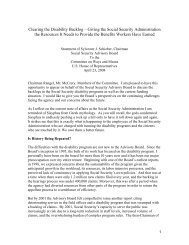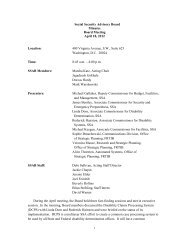Aspects of Disability Decision Making: Data and Materials
Aspects of Disability Decision Making: Data and Materials
Aspects of Disability Decision Making: Data and Materials
You also want an ePaper? Increase the reach of your titles
YUMPU automatically turns print PDFs into web optimized ePapers that Google loves.
D. Important Recent Court Cases <strong>and</strong> Litigation Affecting the <strong>Disability</strong>ProcessISSUE: Medical Improvement St<strong>and</strong>ardThe principal court cases involving the medicalimprovement st<strong>and</strong>ard include Morrison, Doe, <strong>and</strong>Decker, (WA), Holden (OH), Lopez (9 th Circuit).Lawsuits were filed in the 1980s challengingthe st<strong>and</strong>ard that SSA used to cease disability benefitsfor cases that were undergoing a continuingdisability review. As a result <strong>of</strong> the Social Security<strong>Disability</strong> Benefits Reform Act <strong>of</strong> 1984 (P.L. 98-460),there were 17 medical improvement cases that wererem<strong>and</strong>ed to SSA to have the cases reviewed underthe new medical improvement st<strong>and</strong>ard establishedin the law.ISSUE: Pain <strong>and</strong> Other SymptomsThe principal court cases involving the assessment<strong>of</strong> pain <strong>and</strong> other symptoms include Hyatt(NC), Luna (CO), <strong>and</strong> Polaski (8 th Circuit).The Social Security <strong>Disability</strong> Benefits Reform Act<strong>of</strong> 1984 (P.L. 98-460), codified SSA’s policy for evaluatingpain. It sunset on January 1, 1987 <strong>and</strong> was notreplaced.In the 1980s, both before <strong>and</strong> after P.L. 98-460,there was much litigation over how SSA assessedallegations <strong>of</strong> pain. Although the agency concludedthat the court rulings were not in conflict with itspolicy, many courts found that SSA did not giveadequate consideration to the claimant’s allegations<strong>and</strong> other subjective evidence, <strong>and</strong> instead relied tooheavily on objective medical findings to substantiateor rebut pain allegations. In November 1991,SSA issued an agency regulation that incorporatedthe pain st<strong>and</strong>ard that was articulated in thePolaski case.ISSUE: Treating Physician’s OpinionThe principal court cases involving treatingphysician’s opinion include Schisler (NY), <strong>and</strong>Aldrich (VT).Until the 1980s there were no agency regulationson this issue except a short rule that said SSAwas not bound by a treating physician’s opinionabout whether a claimant was disabled. Prior toAugust 1991, several circuit court decisions, includingthe Schisler case, pointed to the need for a clearpolicy statement that would encourage adjudicationuniformity <strong>and</strong> provide the public <strong>and</strong> the courtswith a clear explanation <strong>of</strong> SSA’s policy on theweighing <strong>of</strong> treating source opinions.The Schisler ruling issued on March 8, 1989<strong>and</strong> effective in the States <strong>of</strong> the 2 nd Circuit (NY, VT,<strong>and</strong> CT), was written by the court because it foundthat the language drafted by SSA was, in the court’sview, out <strong>of</strong> synch with 2 nd Circuit law. Recognizingthe need for detailed regulations to provide uniformityacross the country, SSA issued regulationson medical source opinion that were published inAugust 1991. The regulations were challenged inthe 2 nd Circuit, <strong>and</strong> in the third <strong>of</strong> the Schisler decisions,a unanimous court upheld them as withinthe Commissioner’s authority to make rules eventhough it was not completely consistent with2 nd Circuit law up to that point.ISSUE: Disabled Widow(er)sThe principal court cases involving disabledwidows include Hill (NY), Askin (11 th Circuit),Begley (TN), <strong>and</strong> Bozzi (3 rd Circuit).The issue in these cases was the medical evaluationst<strong>and</strong>ard that SSA used in determiningdisability in disabled widow, widower, or survivingdivorced spouse claims. The agency did not providethese individuals with a residual functional capacityevaluation when adjudicating their disability claim.The st<strong>and</strong>ard that adjudicators must use for evaluatinga widow’s entitlement after December 1990is required by the Omnibus Budget Reconciliation Act<strong>of</strong> 1990 (P.L. 101-508). The st<strong>and</strong>ard for evaluatinga widow’s entitlement before January 1991 isrequired by the SSR 91-3p, which was published onMay 5, 1991.ISSUE: HIV/AIDSThe principal court cases involving HIV/AIDSinclude Rosetti (3 rd Circuit), <strong>and</strong> S.P. (NY).The issue was the st<strong>and</strong>ards, policies, practices,<strong>and</strong> procedures that SSA used in evaluating disabilityclaims based in whole or in part on infectionwith HIV/AIDS. Plaintiffs alleged that SSA failed topromulgate properly regulations for claimants sufferingfrom HIV/AIDS by publishing them in theFederal Register for public comments. HIV/AIDS wassubsequently established as an impairment in SSA’sListings <strong>of</strong> Impairments (14.08 <strong>and</strong> 114.008).ISSUE: Not SevereA principal court case involving “not severe” isDixon (NY).This case challenged the validity <strong>of</strong> SSA’s regulationsthat dealt with non-severe impairments (i.e.,step 2 <strong>of</strong> the agency’s sequential evaluation process)<strong>and</strong> SSA’s policy <strong>of</strong> not considering the combined<strong>Aspects</strong> <strong>of</strong> <strong>Disability</strong> <strong>Decision</strong> <strong>Making</strong>: <strong>Data</strong> <strong>and</strong> <strong>Materials</strong> 101









